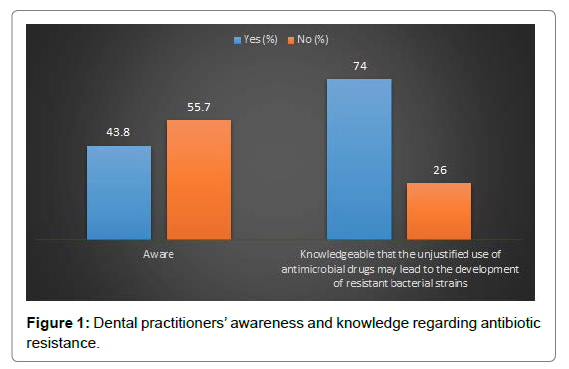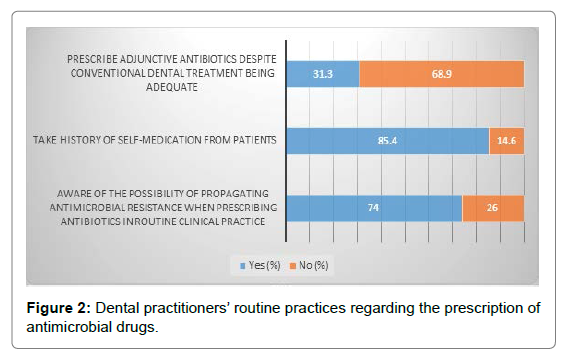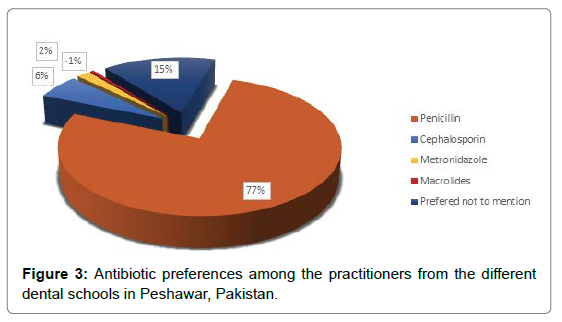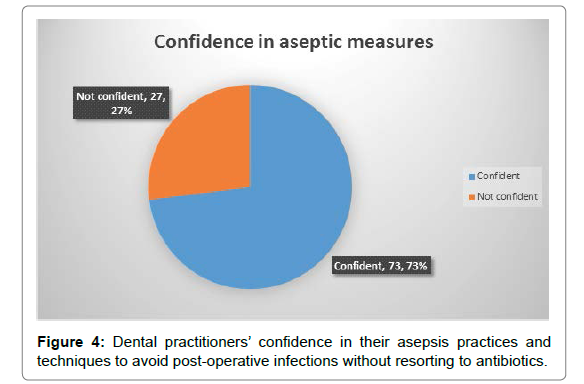Research Article, Dent Health Curr Res Vol: 7 Issue: 8
The Awareness Of Dentists Regarding Antibiotic Resistance In Dental Teaching Hospitals Of Peshawar, Pakistan
Yasir Israr1*, Shaina Zaman2, Siddiq Yousufi3, Zainab Riaz4 and Syed Imran Gilani5
1Department of Orthodontics, Sardar Begum Dental Hospital, Gandhara University, Peshawar, Pakistan
2Bachelor of Dental Surgery, Sardar Begum Dental College, Gandhara University, Peshawar, Pakistan
3Department of Orthodontics, Khyber College of Dentistry, Peshawar, Pakistan
4Bachelor of Dental Surgery, RAK college of Dental Sciences, RAK Medical and Health Sciences University, Ras Al Khaimah, UAE
5Department of Preventive & Community Dentistry, Sardar Begum Dental College & Hospital, Gandhara University, Peshawar, Pakistan
- *Corresponding Author:
- Yasir Israr
Department of Orthodontics, Sardar Begum Dental Hospital, Gandhara University, Peshawar, Pakistan
Tel: +923109679635
E-mail: yasirisrar533@gmail.com
Received Date: August 15, 2021; Accepted Date: August 31, 2021; Published Date: September 07, 2021
Citation: Israr Y, Zaman S, Yousufi S, Riaz Z, Gilani SI (2021) The Awareness of Dentists Regarding Antibiotic Resistance in Dental Teaching Hospitals of Peshawar, Pakistan. Dent Health Curr Res 7:8. 159.
Copyright: © All articles published in Dental Health: Current Research are the property of SciTechnol, and is protected by copyright laws. “Copyright © 2021, SciTechnol, All Rights Reserved.
Abstract
Objectives: Antibiotic resistance is one of the biggest threats to global health and development today. Study was to assess the awareness of dentists regarding antibiotic resistance in the dental teaching hospitals of Peshawar, Pakistan.
Methodology: Questionnaires were distributed to 250 dental practitioners working in the dental hospitals in Peshawar. Questionnaire evaluated awareness of dental clinicians regarding antimicrobial resistance. It sought answers to parameters influencing their decisions towards the need to prescribe antibiotics.
Results: 219 (88%) out of the 250 questionnaires were returned. 109 (49.8%) of the respondents were males. Analyses revealed around 55% of the dental practitioners were unaware of the concept of antimicrobial resistance. 31% of the participants considered prescribing adjunctive antibiotics despite conventional dental treatment being adequate. Before prescribing antibiotics, 14% of the practitioners did not deliberate taking a thorough history of self-medication from their patients. And a percentage like 25% did not consider the possibility of propagating antimicrobial resistance when prescribing antibiotics in their routine clinical practice. Penicillin was reported to be the most frequently prescribed antibiotic at 76%.
The questionnaire also revealed 27% lacked confidence in their asepsis practice during clinical procedures resorting to the prescription of antibiotics in order to prevent any risk of postoperative infections.
Conclusion: The participants were found to have mediocre knowledge in the area of antimicrobial prescribing and resistance. Coordinated efforts to implement new policies, renew research efforts, and pursue steps to manage this global crisis of antimicrobial resistance are greatly needed.
Keywords: Antibiotics, Antimicrobial Resistance, Antibiotic abuse, Dental practice, Prescription
Introduction
Antimicrobials have proved to be a potent weapon in the arsenal of health professionals in tackling high mortality rates among communities suffering from infectious diseases [1]. Owing to Alexander Fleming’s discovery in 1928, millions of lives have been saved to date by their requisite intervention in ailing individuals [2]. They have also paved their way into the dental profession not only as therapeutic drugs prescribed following basic dental surgeries and/or major maxillofacial procedures but also as prophylactic adjuncts in immuno-compromised individuals [3]. However, in contrast to other branches of medicine, the prescription of antibiotics in the field of dentistry remains mostly at the discretion of the dental practitioner and not affirmative to standard guidelines provided by evidence based researches [4].
Like everything with its own characteristic set of advantages and disadvantages, antibiotics despite their innumerable benefits do carry some detrimental effects [2]. The most worrisome being their haphazard and unjudicial prescription promoting the development of superbugs or resistant bacteria defined by the Center for Disease Control (CDC) as “bacteria changing in ways that reduce or eliminate the effectiveness of drugs, chemicals or other agents to cure or prevent infections” [5]. There has been a definitive association between an egregious antimicrobial consumption and the development of subsequent resistant bacterial strains [6].
Now classified as a global health problem, antimicrobial resistance poses a serious threat to the chances of effectively preventing or treating infections using the dwindling stock of antibiotics present. The WHO has officially recognized it setting the theme for 2011 as “Antibiotics resistance: no action today, no cure tomorrow” [7]. Factually, studies have reported 10.4% of all Streptococcus pneumoniae isolates to be resistant to penicillin and 16.5% resistant to macrolides in 1996. These proportions were found to rise to 14.1% and 21.9% respectively by 1997. A more recent susceptibility study conducted in 2000–2001 reported 51.5% and 30.0% of all S. pneumoniae isolates to be resistant to penicillin and macrolides correspondingly [8]. This is one example among others of how the misuse and overuse of antimicrobial drugs stands responsible for accelerating this process [9-14].
In developing countries, there is a multifaceted mode of transmission of these resistant bacteria due to a general lack of awareness of public health. This can also be attributed to poor intervention by the government in the implementation of concrete measures to combat the issue in hand by devising adequate policies and guidelines. Previously controlled morbidity and mortality rates from microbial infections can now be seen to rebound owing to these resistant strains [15]. There have been numerous researches citing that dentists prescribe 7-11% of the routine antibiotic prescription, but their responsibility in the growing trend of antimicrobial resistance has yet to be brought to light with concrete figures [5, 16]. Global health, security and gross development are most threatened by the emergence of resistant strains. This, therefore, is pushing a good incentive to pursue this study. This survey aims to draw an assessment concerning the awareness of dentists regarding antibiotic resistance in the dental teaching hospitals of Peshawar, Pakistan.
Materials and Methods
The study is of a descriptive nature of the cross-sectional subtype, where a self-administered type of questionnaire was distributed among the participants. After approval from the research and ethics committee of Sardar Begum Dental College, Gandhara university, it was carried out during the period of November-December, 2018.
A total of 250 questionnaires were distributed among the principal clinical staff of the four major dental hospitals of Peshawar, which were Sardar Begum Dental Hospital, Khyber College of Dentistry, Rehman College of Dentistry and Peshawar Dental College. The participants comprised of house officers, post graduate trainees, and teaching faculty related to clinical science. After taking consent from the participants and helping them understand the questions, they were recollected on the same day.
The questionnaire contained some parts related to the basic demographics associated with the dental profession including the speciality as well as number of years associated with clinical work, which also provided a certain degree of flexibility to the participants by inclusion of some open-ended questions. The awareness regarding antimicrobial resistance was the main goal behind the conception of the questionnaire, also including the various parameters which influenced the clinician’s decision to prescribe antibiotics to the patients.
After excluding incomplete surveys and surveys with failed intraparticipant consistency, the analysis software SPSS version 16.0 was used to compile and tabulate the results and the descriptive data was compared using chi square testing. The level of statistical significance of most of the performed tests was p-value < 0.05.
Results
A total of 219 (88%) forms were returned and adequately filled out of the 250 that were sent out. Table 1 shows the demographic and professional characteristics of the respondents.
| Variables | n (%) |
|---|---|
| Gender | |
| Females | 94 (42.9) |
| Males | 109 (49.8) |
| College: | |
| Sardar Begum Dental College | 86 (39.3) |
| Khyber College of Dentistry | 69 (31.5) |
| Rehman College of Dentistry | 28 (12.8) |
| Peshawar Dental College | 36 (16.4) |
| Professsional category | |
| House surgeons/Internees | 85 (38.8) |
| Specialist trainees | 56 (25.6) |
| Assistant professors | 6 (2.7) |
| Associate professors | 4 (1.8) |
| Professors | 5 (2.3) |
| Medical officers/Demonstrators | 14 (6.4) |
| Department | |
| Oral and maxillofacial surgery & clinical orthodontics | 40 (18.3) |
| Oral prosthodontics | 31 (14.2) |
| Clinical endodontics and operative dentistry | 27 (12.3) |
| Clinical periodontics | 18 (8.2) |
| Pediatric dentistry | 7 (3.2) |
| Years in practice | |
| 0-5 | 172 (78.5) |
| 06-Oct | 35 (16) |
| Nov-15 | 5 (2.3) |
| 16-20 | 5 (2.3) |
| >21 | 3 (1.4) |
94 (42.9%) of the respondents were females and 109 (49.8%) were males. Among the participants, majority (38.8%) were house surgeons or internees belonging to the oral & maxillofacial surgery and clinical orthodontic departments (18.3%). The associate professors were the minority (1.8%). The majority of the participants (78.5%) had practiced dentistry for up to 5 years. The p-values for almost all the variables stood greater than 0.05 proving no specific correlation between the numbers of years associated with the profession and the knowledge of antibiotic resistance.
Data analysis from our survey revealed that although 74% of the dental practitioners had the knowledge that unjustified use of antibiotics may lead to the development of resistant bacterial strains, around 55% were not aware of the concept of antimicrobial resistance (Figure 1).
Of the participants, 31% of the clinicians were found to consider prescribing adjunctive antibiotics despite conventional dental treatment being adequate. Before prescribing antibiotics, a meager 14% of the practitioners did not deliberate taking a thorough history of self-medication from their patients. And a percentage like 25% did not consider the possibility of propagating antimicrobial resistance when prescribing antibiotics in their routine clinical practice (Figure 2).
The survey further explored the antibiotic preferences among the practitioners from the different dental schools where Penicillin was reported to be the most frequently prescribed antibiotic at 76%, followed by the choice of a Cephalosporin or Metronidazole at 6% and 2% respectively (Figure 3).
Finally, 27% of the respondents displayed a lack of confidence in their practices of asepsis during clinical procedures resorting to the prescription of antibiotics in order to prevent any risk of postoperative infections (Figure 4).
Discussion
This questionnaire based cross-sectional study is the first attempt of its kind to comprehensively assess the attitudes of dentists towards the prescription of antibiotics, to quantify factors that exert a strong influence on their decision to prescribe the said medications as well as their knowledge and awareness regarding the global health problem of antimicrobial resistance. The study was aimed at dental professionals working in Peshawar, Pakistan. There has been an excellent response rate of almost 88%, with majority of them being house officers who are the main workforce in the dental hospitals.
Antimicrobial resistance is emerging globally as a dangerous threat, jeopardizing the ability of populations to combat common infections. The main aim of this survey was to draw an assessment concerning the awareness of dentists regarding antibiotic resistance in the dental teaching hospitals of Peshawar, Pakistan.
The results of our survey present with some very worrying statistics as more than 50% of our respondents were unaware of the concept of antimicrobial resistance and its repercussions, in contrast to just 28.3% of dental practitioners according to a similar study conducted in Riyadh [17]. 74% of the dental practitioners had the knowledge that unjustified use of antibiotics may lead to the development of resistant bacterial strains similar to studies conducted by Ikram et al and Baadani et al where 82% and 86% of their respondents shared the same belief respectively [13,9]. This, however, outranks the results from another study in Chennai [12]. The findings from different studies deduce that there is an urgent need to bring out educational reforms and training programs where the threat of antimicrobial resistance is given its due diligence and the discerning chasm between the knowledge and clinical practice is bridged.
Of the total participants in our survey, 31% of the clinicians were found to consider prescribing adjunctive antibiotics despite conventional dental treatment being adequate while a study conducted in Karachi found 64% of the practitioners affirming to this statement too [13]. There is plenty evidence suggesting that the use of adjunctive antibiotics is ill advised in cases where local debridement of infectious tissues can get the job done, provided there is no evidence of systemic spread. Discerning chasms between possessing knowledge and its application in clinical practice cannot be ignored and these results necessitate educators to stress upon the concept that antibiotics should only be used as adjunctive therapy and not as a standalone first line of treatment [14, 18]. Self-medication is another emerging factor in the development of antibiotics and should not be underestimated. Before prescribing antibiotics, a quite sensible percentage of the practitioners (86%) deliberated taking a thorough history of self-medication from their patients. This is justified and impressive.
A percentage like 25% of the clinicians from Peshawar did not consider the possibility of propagating antimicrobial resistance when prescribing antibiotics in their routine clinical practice and these statistics were not found to be very different from a study conducted in Mangalore where 32% of the dental practitioners were reported to practice the same [11]. A staggering 58% dentists from Karachi prescribed antibiotics empirically as well [19]. This is a clear indication of how unprofessionalism and clinical misjudgments are more often than not given priority over factual knowledge and logic.
In dental practice, Penicillin is the most commonly prescribed antibiotic. Other antibiotics like Penicillin V, Amoxicillin and Metronidazole are, however, becoming increasingly popular. Our current study showed Penicillin as the first choice of antibiotic (76%) prescribed by dental practitioners, which is comparable to findings reported in Saudi Arabia and other cities in Pakistan [9-17]. This affinity towards Penicillin being the drug of choice is concerning and should raise some eyebrows as an increasingly resistant microbiota to the antibiotic have been reported [20-26].
Despite some gloomy results, there have been some encouraging findings where the respondents (73%) were confident with their aseptic measures and techniques, as opposed to the 27% of the respondents who displayed a lack of confidence resorting to the prescription of antibiotics in order to prevent any risk of postoperative infections. This can be taken as an ideal starting point for pro-active training activities as practicing infection control policies are the basic measures to fight all kinds of infections and ultimately antimicrobial resistance.
Conclusion
In this study sample of dental practitioners practicing in Peshawar, the practitioners were found to have generally fair knowledge and awareness in the area of antimicrobial prescribing. The rapid emergences of resistant strains of bacteria are weakening the foundations of the therapeutic effects of antibiotics. This crisis is global, reflecting the worldwide overuse of these drugs and the lack of development of new antibiotic agents by pharmaceutical companies to address the challenge. Coordinated efforts to implement new policies, renew research efforts, and pursue steps to manage the crisis are greatly needed.
In an era where antimicrobial resistance is a ticking time bomb, stringent measures in prescribing and dispensing antibiotics should be followed without which we may be heading towards high morbidity and mortality rates owing to common infections and minor injuries. It is time for an action to be taken in order to lessen the impact of the emergence of antibiotic-resistant bacteria in the near future.
References
- Velez R, Sloand E. (2016) Combating antibiotic resistance, mitigating future threats and ongoing initiatives. J Clin Nurs 25:1886-1889.
- Suchi K, Praveen J. (2015) Antibiotics in dentistry a boon or bane. J Dent App 2:132-137.
- Cope A, Francis N, Wood F, Chestnutt I. (2015) Antibiotic prescribing in UK general dental practice: a cross-sectional study. Community Dent Oral Epidemiol 44:145-153.
- Kim H, Oh JK, Kim MK, Bae K, Choi H. (2017) Reduced antibiotic prescription rates following physician-targeted interventions in a dental practice. Acta Odontologica Scandinavica 76:204-211.
- Begum A, MRA. (2018) Antibiotics in Dentistry-Double-Edged Sword. J Dent Sci 3:000161.
- Lund B, Cederlund A, Hultin M, Lundgren F. (2020) Effect of governmental strategies on antibiotic prescription in dentistry. Acta Odontologica Scandinavica 78:529-534.
- World Health Organization. (2001). WHO Global Strategy for Containment of Antimicrobial Resistance, USA.
- López-Alcalde J, Rodriguez-Barrientos R, Redondo-Sánchez J, Muñoz-Gutiérrez J, Molero García J et al. (2018) Short-course versus long-course therapy of the same antibiotic for community-acquired pneumonia in adolescent and adult outpatients. Cochrane Database Syst Rev.
- Labricciosa F, Sartelli M, Correia S, Abbo L, Severo M et al. (2018) Emergency surgeons perceptions and attitudes towards antibiotic prescribing and resistance: a worldwide cross-sectional survey. World J Emerg Surg 13.
- Poveda Roda R, Bagán JV, Sanchis Bielsa JM, Carbonell Pastor E. (2007) Antibiotic use in dental practice: A review. Medicina Oral, Patología Oral y Cirugía Bucal 12:186-192.
- Punj A, Shenoy SB, Thomas B, Ramesh A. (2016) Knowledge awareness and prescription practice of antibiotics among private dental practitioners in Mangalore. J Educ Ethics Dent 6:72-77.
- Shivanni SS, Roy A. (2017) Knowledge and awareness of antibiotic resistance among dental students. Int J Sci Res 6:1343-1345.
- Ikram K, Ahmed A, Siddiqui HK, Maqbool S, Mushtaq S et al. (2015) Over prescription of antibiotics by Karachi dentists working in public and private sector. Pak Oral Dental J 35:10-12.
- Ismail F, Qazia S, Sajjada A. (2018) Antibiotics prescription habits and knowledge of dentists in a Lahore sample. Pak Oral Dental J 38:79-84.
- N’Diaye D, Nsengiyumva N, Uppal A, Oxlade O, Alvarez G, et al. (2017) The potential impact and cost-effectiveness of tobacco reduction strategies for tuberculosis prevention in Canadian Inuit communities. BMC Med 17:1-1.
- Segura-Egea JJ, Martín-González J, del Carmen Jiménez-Sánchez M, Crespo-Gallardo I, Saúco-Márquez JJ et al. (2017) Worldwide pattern of antibiotic prescription in endodontic infections. Int Dent J 67:197-205.
- AboAlSamh A, Alhussain A, Alanazi N, Alahmari R, Shaheen N et al. (2018) Dental students’ knowledge and attitudes towards antibiotic prescribing guidelines in Riyadh, Saudi Arabia. Pharmacy 6:42.
- Durkin MJ, Feng Q, Suda KJ, Lockhart PB, Thornhill MH et al. (2019) Longitudinal antibiotic prescribing trends among US dental specialists within a pharmacy benefits manager, 2013 through 2015. J Am Dent Assoc 150:846-853.
- Stein K, Farmer J, Singhal S, Marra F, Sutherland S et al. (2018) The use and misuse of antibiotics in dentistry: a scoping review. J Am Dent Assoc 149:869-884.
- Watanabe N, Kobayashi K, Koyama S, Tabira M, Matsuno J et al. (2020) Bloodstream infection by multidrug resistant Streptococcus oralis in a leukemic patient with febrile neutropenia after hematopoietic stem cell transplantation. Transpl Infect Dis 22:e13246.
- Zhang Y, Wang X, Li H, Ni C, Du Z, Yan F. (2018) Human oral microbiota and its modulation for oral health. Biomed Pharmacother 99:883-893.
- Munita JM, Arias CA. (2016) Mechanisms of antibiotic resistance. Virulence Mechanisms of Bacterial Pathogens 481-511.
- Ramos E, Santamaría J, Santamaría G, Barbier L, Arteagoitia I. (2016) Do systemic antibiotics prevent dry socket and infection after third molar extraction? A systematic review and meta-analysis. Oral Surg Oral Med Oral Pathol Oral Radiol 122:403-425.
- Marra F, George D, Chong M, Sutherland S, Patrick DM. (2016) Antibiotic prescribing by dentists has increased: Why?. J Am Dent Assoc 147:320-327.
- Dar-Odeh NS, Abu-Hammad OA, Al-Omiri MK, Khraisat AS, Shehabi AA. (2010) Antibiotic prescribing practices by dentists: a review. Ther Clin Risk Manag 6:301-306.
- Ytreland KJ. (2018) Antibiotic use and antibiotic resistance in dental practice.
 Spanish
Spanish  Chinese
Chinese  Russian
Russian  German
German  French
French  Japanese
Japanese  Portuguese
Portuguese  Hindi
Hindi 



